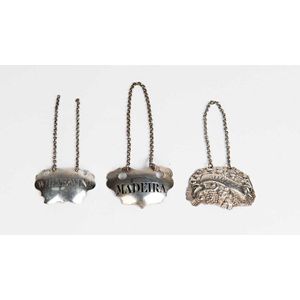Sterling silver wine labels collection
You must be a subscriber, and be logged in to view price and dealer details.
Subscribe Now to view actual auction price for this item
When you subscribe, you have the option of setting the currency in which to display prices to $Au, $US, $NZ or Stg.
- Bacchus Motif - The Bacchus motif is a design that features the Roman god Bacchus, who is the god of wine, parties, and celebration. Bacchus is often depicted as a young man with long hair and a beard, holding a bunch of grapes or a wine cup. The Bacchus motif is often used in art and design as a symbol of abundance, revellery, and enjoyment. It can be found on a variety of decorative items, including glassware, ceramics, and other home decor items. The Bacchus motif represents the joy and celebration that can be found in social gatherings and the pleasures of good food and drink.
- Putto / Putti / Amorino / Amorini - A putto (plural: putti) or amerino (plural: amerini) is a cherub or cupid frequently appearing in both mythological and religious paintings and sculpture, especially of the Renaissance and Baroque periods and later used as a decorative element in the design of furniture, ceramics, statuary etc. They are usually depicted as chubby males, or of indeterminate gender, often with wings. Their depiction may represent an association with love, heaven, peace or prosperity.
- Circa - A Latin term meaning 'about', often used in the antique trade to give an approximate date for the piece, usually considered to be five years on either side of the circa year. Thus, circa 1900 means the piece was made about 1900, probably between 1895 and 1905. The expression is sometimes abbreviated to c.1900.
- Sterling Silver - Sterling silver is a mixture of 92.5% pure silver and 7.5% of another metal, usually copper. Fine silver is 99.9% pure silver, and is relatively soft and the addition of the very small amount of copper gives the metal enough strength and hardness to be worked into jewellery, decorative and household objects.
This item has been included into following indexes:
Visually similar items

A pair of Tahitian pearl and diamond earrings. 18ct white gold, made as simple short drops, each set with a large round Tahitian pearl measuring approximately 14.3 mm, medium silver grey in colour with a faint peacock overtone and high lustre, surmounted b

Three Irish and one English Georgian sterling silver dessert spoons, 1835 Dublin, with makers' marks for Phillip Weekes or Peter Walsh and;, 1835 London, with maker's mark for William Johnson, all of fiddle pattern design, the Irish spoons with matching in

A pair of Tahitian pearl earrings; 10.4 mm round fine cultured pearls on 14ct gold shepherds hooks.

A pair South Sea pearl & diamond earrings; each a 9.5 mm round cultured pearl of fine colour with high lustre on an 18ct white gold line drop set with 13 round brilliant cut diamonds. Length 30 mm. Wt. 5g.
